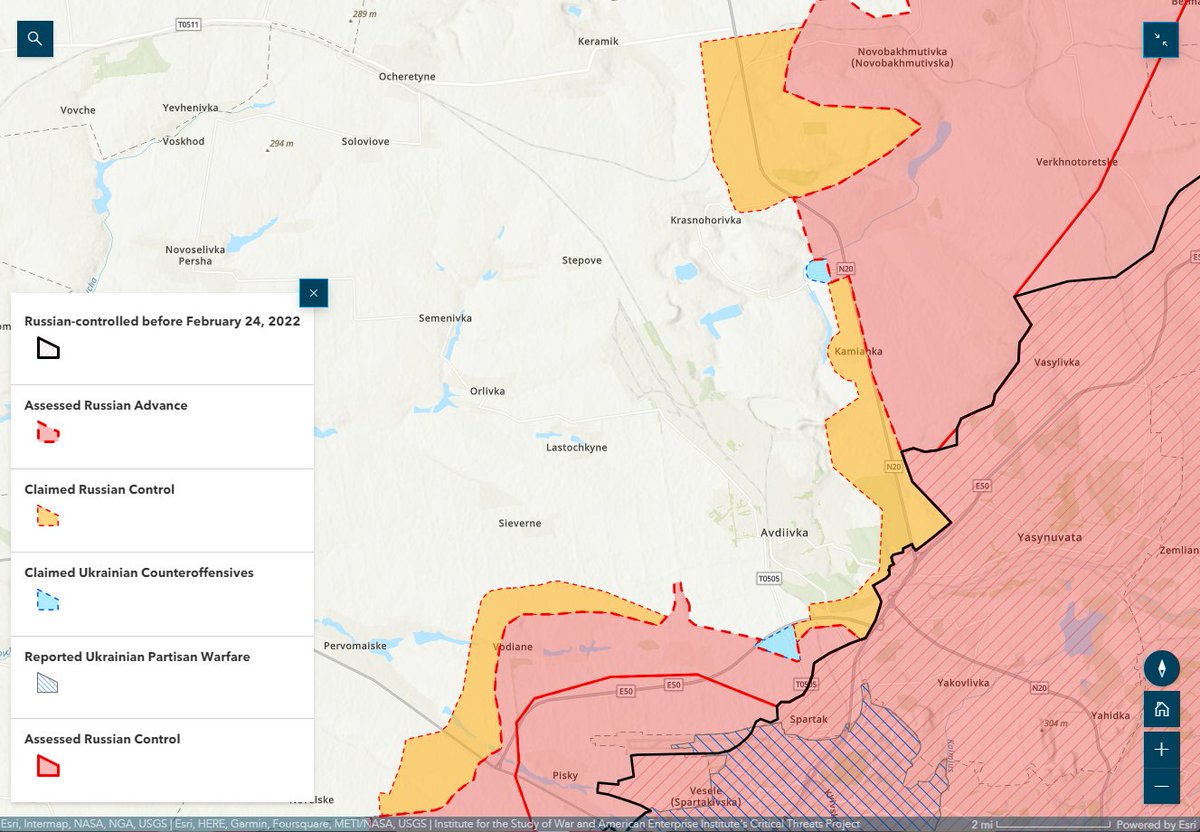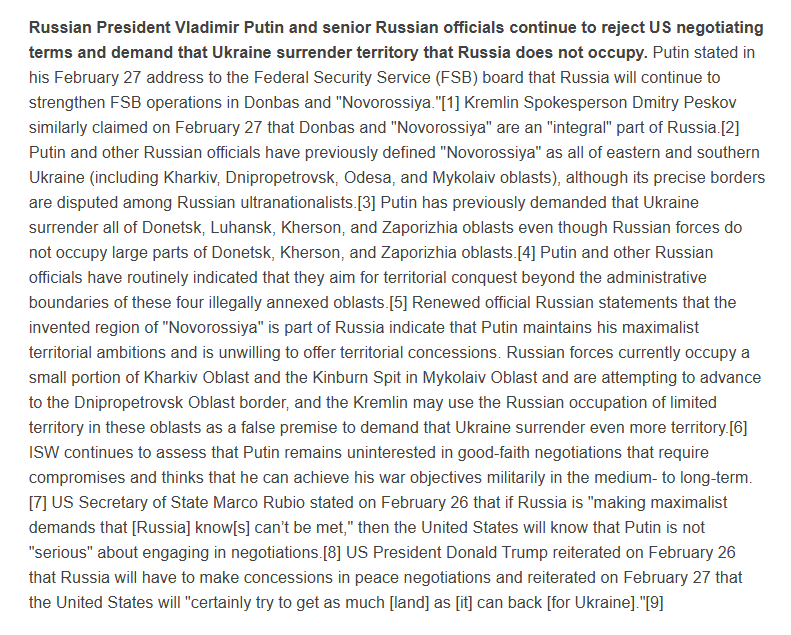Eastern #Ukraine: #Donetsk Oblast
Russian forces made marginal territorial gains around #Bakhmut and #Avdiivka and continued to conduct ground attacks across the Donetsk Oblast front line. 🧵(1/20)
isw.pub/UkrWar022523
Russian forces made marginal territorial gains around #Bakhmut and #Avdiivka and continued to conduct ground attacks across the Donetsk Oblast front line. 🧵(1/20)
isw.pub/UkrWar022523
https://twitter.com/TheStudyofWar/status/1629656119705567234
2/ #Bakhmut:
The Ukrainian General Staff reported that Russian forces conducted unsuccessful offensive operations near Orikhovo-Vasylivka (11km northwest of Bakhmut), Berkhivka (4km north of Bakhmut), Ivanivske (6km west of Bakhmut), and Pivnichne (21km southwest of Bakhmut).
The Ukrainian General Staff reported that Russian forces conducted unsuccessful offensive operations near Orikhovo-Vasylivka (11km northwest of Bakhmut), Berkhivka (4km north of Bakhmut), Ivanivske (6km west of Bakhmut), and Pivnichne (21km southwest of Bakhmut).

3/ Yevgeny #Prigozhin claimed that his #Wagner Group fighters captured #Yahidne (2km north of Bakhmut) and posted a picture of Wagner fighters posing near the settlement’s welcome sign that was later geolocated, indicating that Wagner fighters likely captured the settlement. 

4/ Russian sources continued to claim that #WagnerGroup fighters captured #Berkhivka and completed clearing the settlement, although ISW has not observed visual confirmation of these claims. 

5/ Russian sources provided conflicting claims about gains near Dubovo-Vasylivka (6km NW of Bakhmut): an occupation official claimed that it was captured; a prominent milblogger claimed Russian forces only entered it; another milblogger said fighting was ongoing on its outskirts. 

7/ Russian sources claimed that Ukrainian forces destroyed a dam north of #Bakhmut and flooded the Stupky area of Bakhmut in order to slow Russian advances from the north, although ISW has seen no visual evidence of these claims.
8/ Russian milbloggers claimed that Wagner fighters conducted assaults near Zaliznianske (11km north of Bakhmut), Vasyukivka (14km north of Bakhmut), Rozdolivka (17km northeast of Bakhmut), and Fedorivka (18km north of Bakhmut). 

9/ Geolocated footage published on February 24 indicates that Russian forces likely made marginal advances in eastern #Bakhmut. 

10/ The Ukrainian Border Guards Service reported that the Russians have committed their most combat-ready forces to Bakhmut and that there are many Wagner Group convict personnel around the city.
11/ Russian milbloggers claimed that Russian forces advanced in the southern part of #Bakhmut and that Wagner fighters conducted ground attacks near Chasiv Yar (12km west of Bakhmut) and Dyliivka (15km southwest of Bakhmut). isw.pub/UkrWar022523 

12/ #Avdiivka - Donetsk City
Russian forces continued offensive operations along the western outskirts of #Donetsk City on February 25.
Russian forces continued offensive operations along the western outskirts of #Donetsk City on February 25.
13/ The Ukrainian General Staff reported that Russian forces conducted unsuccessful offensive actions near #Avdiivka and within 36km southwest of Avdiivka near Vodyane, Pervomaiske, Nevelske, Marinka, and Novomykhailivka. 

14/ Geolocated footage published on February 25 indicates that Russian forces likely made marginal advances southwest of #Avdiivka and near Pobieda (32km southwest of Avdiivka). 

15/ Western #Donetsk
Russian forces continued offensive operations in western Donetsk Oblast on February 25. Representative of the Ukrainian Tavriisk operational direction Oleksiy Dmytrashkivyskyi reported that Russian forces conducted attacks near #Vuhledar.
Russian forces continued offensive operations in western Donetsk Oblast on February 25. Representative of the Ukrainian Tavriisk operational direction Oleksiy Dmytrashkivyskyi reported that Russian forces conducted attacks near #Vuhledar.

16/ According to Dmytrashkivyskyi Russian forces have not changed their tactics near #Vuhledar but there has been an increase in Russian forces conducting assaults without armored support...
17/ ... and even some instances of armored personnel carriers driving infantry to the frontline for dismounted assaults and then withdrawing.
18/ Dymtrashkivyskyi also reported that Russian forces transferred an unspecified number of personnel by bus from #Melitopol to the area to replenish the 155th and 40th Naval Infantry Brigades.
19/ ISW has previously reported that 43 buses of #Wagner fighters arrived in #Melitopol possibly representing one or two battalions’ worth of personnel, and Russian forces may have since transferred this group of Wagner personnel to the #Vuhledar area.
20/ ISW has not observed any visual confirmation of #Wagner fighters operating in the #Vuhledar area, and Russian forces could also have transferred mobilized personnel to replenish the severely degraded naval infantry formations. isw.pub/UkrWar022523
• • •
Missing some Tweet in this thread? You can try to
force a refresh


























